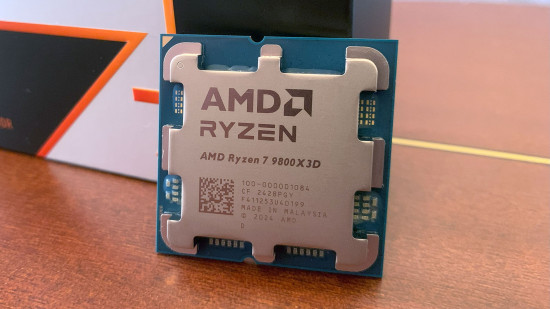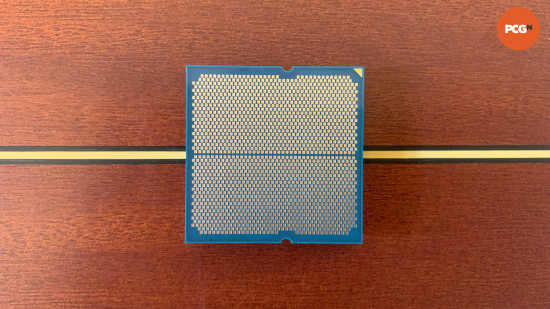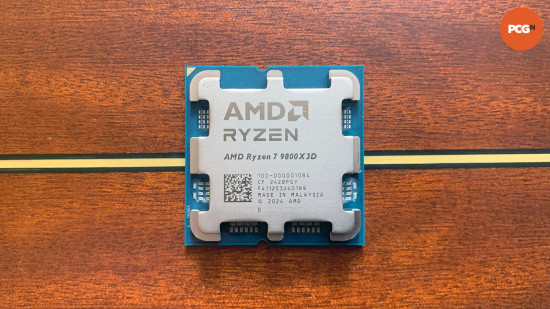Our Verdict
The AMD Ryzen 7 9800X3D is quite simply the fastest gaming CPU you can buy right now. It makes a mockery of Intel Arrow Lake, its frame rates are quicker than those of the 7800X3D, and its extra clock speed gives it a serious boost in multi-threaded software too. It's expensive, but just about worth the extra cost if you're a gamer.
- Amazing game performance
- Much quicker app performance than 7800X3D
- Overclockable
- Runs cooler than 7800X3D
- Higher power draw than 7800X3D
- Expensive asking price
- Only eight cores
- Boost clock could be higher
Every now and then a component comes along that just nails the brief, without you having to add a big disclaimer to the end of your recommendation. The Nvidia GeForce RTX 3080 did it (before it sold out), the Intel Core 2 Quad Q6600 did it, and now the AMD Ryzen 7 9800X3D has done it in quite spectacular fashion. After the lackluster Zen 5 launch, AMD has pulled out all the stops with this new gaming CPU, fixing the app performance of the 7800X3D, and making its new chip even quicker in games.
Is this latest AMD chip the new best gaming CPU? In a word, yes. Not only does it leave Intel Arrow Lake in the dust, but it’s also notably quicker than its predecessor, especially in application software, but also in games. I’ve tested this new X3D chip in several games over the last couple of weeks, while also putting it through its paces in video encoding and rendering tests, and it’s a genuinely great processor.
Why you can trust our advice ✔ At PCGamesN, our experts spend hours testing hardware and reviewing games and VPNs. We share honest, unbiased opinions to help you buy the best. Find out how we test.
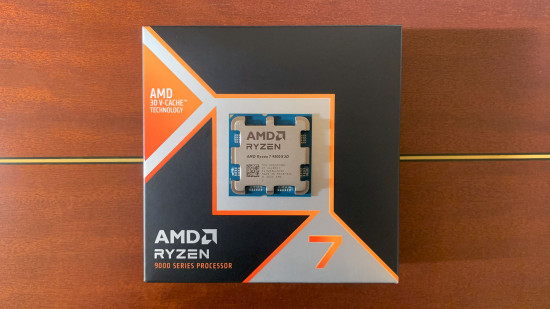
Specs
| Ryzen 7 9800X3D | |
| Cores | 8 |
| Threads | 16 |
| Peak boost clock | 5.2GHz |
| Base clock | 4.7GHz |
| L2 cache | 8MB |
| L3 cache | 96MB (32MB + 64MB 3D V-cache) |
| SMT | Yes |
| TDP | 120W |
| Socket | AMD Socket AM5 |
The Ryzen 7 9800X3D sees AMD taking a new approach to its X3D chips, and it refers to the new structure as 2nd Gen 3D V-cache. The change is quite simple, but it has profound implications. Basically, instead of the cache sitting on top of the CPU cores, as it did with the Ryzen 7 7800X3D, it now sits underneath the eight-core chiplet that contains the CPU cores.
The idea, according to AMD, is that this means the CPU cores are nearest the heatspreader, and thus the contact plate of your CPU cooler, rather than the cache. It’s a fair point. After all, it’s the CPU cores that are in more need of cooling than the cache, and that extra cooling headroom has also enabled AMD to increase the clock speed.
In particular, the 9800X3D boost clock now sits at 5.2GHz, compared to the slightly lower 5GHz boost clock of the 7800X3D. Moreover, the base clock has also been given a big bump, up from 4.2GHz to 4.7GHz. That means the chip is much more able to sustain higher clock speeds across multiple cores compared to its predecessor, as well as boost to a higher peak speed on fewer cores. It’s not a huge increase, but it’s very welcome.
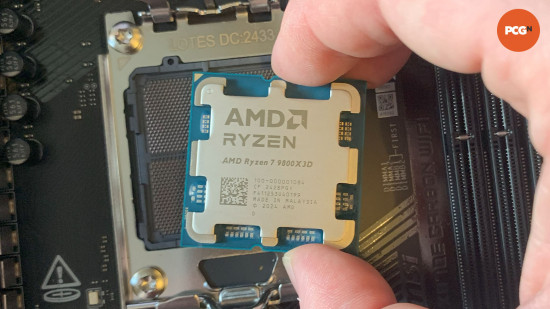
In addition, unlike the 7800X3D, AMD has also unlocked the multiplier of the 9800X3D, meaning you can overclock it too. I’ll be looking at overclocking the 9800X3D in a future guide, but in the meantime, it’s good to see this eight-core X3D chip having a higher boost clock in the first place.
The other big change, of course, is the move from the Zen 4 architecture of the 7800X3D to the new Zen 5 architecture with the 9800X3D, which should give it a little bit of a performance boost as well. Otherwise, the 7800X3D and 9800X3D have fairly similar specs, with the same eight cores, and the same 64MB of extra 3D V-cache – add the existing 32MB of L3 cache in the chip, and you get a total of 96MB L3 cache.
Unlike the new Intel Arrow Lake CPUs, which have Hyper-Threading disabled, the 9800X3D also has SMT enabled, so it can also split its resources into eight virtual cores in addition to its eight physical cores, meaning it can execute 16 concurrent threads in heavily multi-threaded software, rather than just eight.
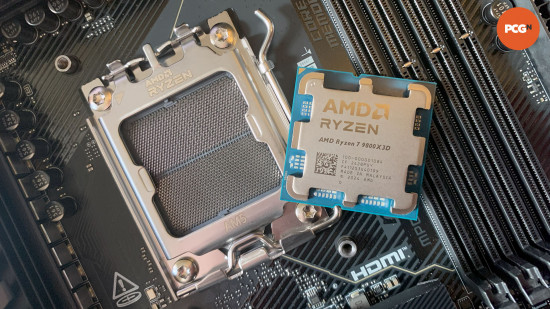
Test setup
We’ve tested the AMD Ryzen 7 9800X3D using a new MSI X870E Carbon WiFi motherboard (a board that will get you a free $50 Steam code from MSI right now), and we’ve also retested the 7800X3D on the same board to get comparison figures. We’ve also used the same 32GB of (2 x 16GB) G.Skill TridentZ 5 Neo RGB 6,000MHz, CL28 RAM that we used in our recent Intel Core Ultra 7 265K review.
Otherwise, our test kit for the 9800X3D remains the same as that for our other CPU tests, including a 2TB WD Black SN850X SSD, as well as a Corsair H100x 240mm AIO cooler, a Corsair RM1000x PSU, and an Nvidia GeForce RTX 4080 Founders Edition graphics card.
All our tests were conducted using Windows 11 24H2, and with the latest BIOS version of the motherboard, which was 802 at the time of testing. The comparison Intel 14th-gen tests in the graphs below were conducted using an Asus Z790 Dark Hero motherboard and Corsair Vengeance RGB DDR5 RAM running at 6,000MHz, CL36.
| PCGamesN 9800X3D test rig | |
| RAM | 32GB (2 x 16GB) G.Skill TridentZ 5 Neo RGB 6,000MHz, CL28 |
| Graphics card | Nvidia GeForce RTX 4080 Founders Edition |
| Motherboard | MSI X870E Carbon WiFi |
| PSU | Corsair RM1000x |
| CPU cooler | Corsair H100x Elite (240mm AIO) |
| SSD | 2TB WD Black SN850X |
| Operating system | Windows 11 24H2 |
Game benchmarks
Let’s cut to the chase, the Ryzen 7 9800X3D is the best CPU I’ve ever benchmarked when it comes to gaming. The difference between this chip and its predecessor is more pronounced in some tests than others, but it’s consistently at the top of the charts, and well ahead of the Core Ultra 7 265K.
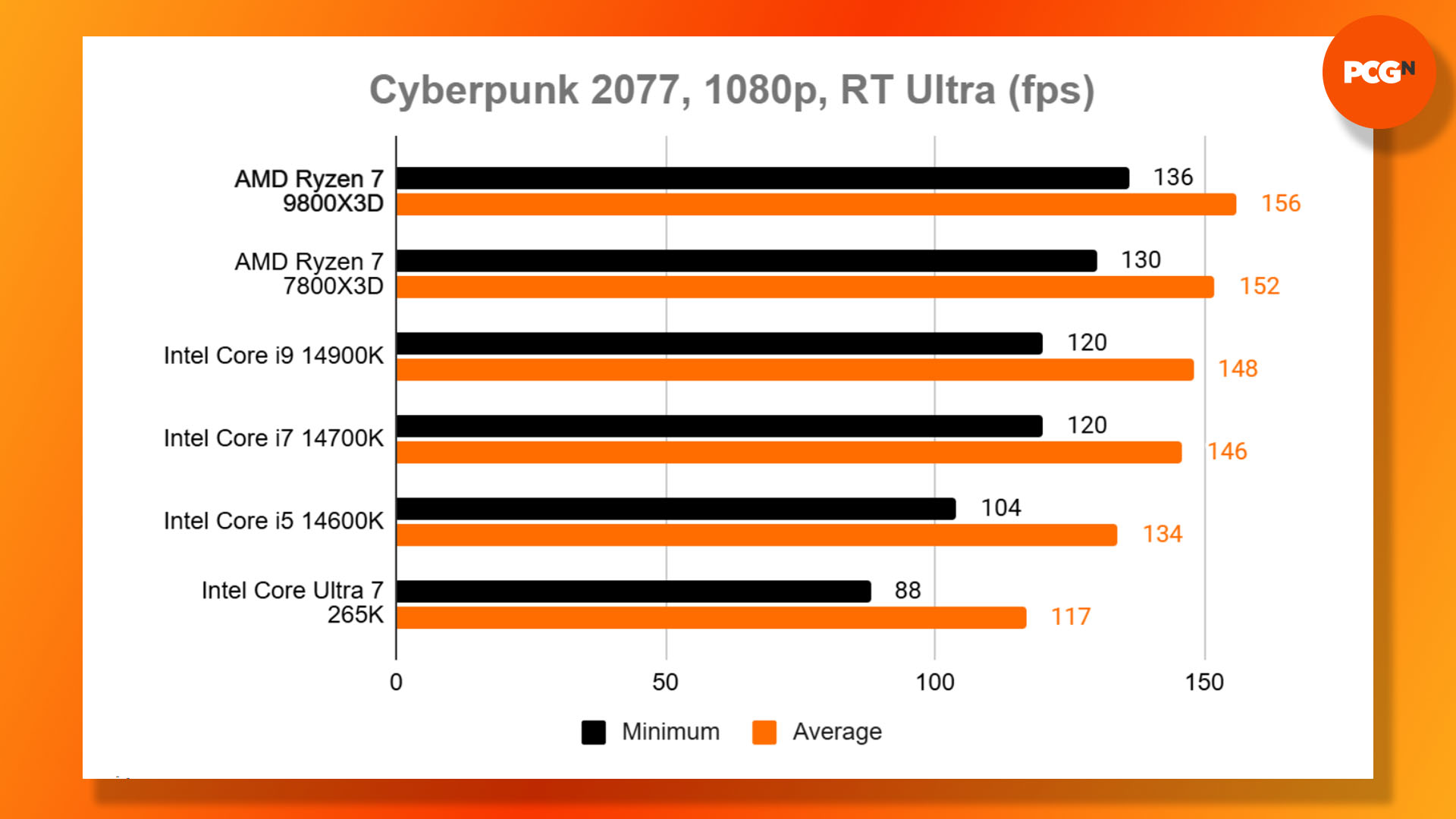
Let’s start with Cyberpunk 2077, which I ran at 1,920 x 1,080 with the Ultra ray tracing preset, and with DLSS Super Resolution enabled on the Quality setting. As you can see in the graph above, the 9800X3D is well in front of the 7800X3D, adding 4fps to the average frame rate and 6fps to the minimum.
Comparatively, the Intel 14th-gen chips, such as the Core i9 14900K, have significantly lower minimums, with a top average of 148fps. This drops all the way down to a minimum of 104fps and an average of 134fps on the Core i5 14600K. The real kicker for Intel in this test, though, is the performance of the Core Ultra 7 265K, which is languishing on a 117fps average and 88fps minimum. Comparatively, the 9800X3D is 33% faster, which is an incredible difference to gain just from swapping CPUs.
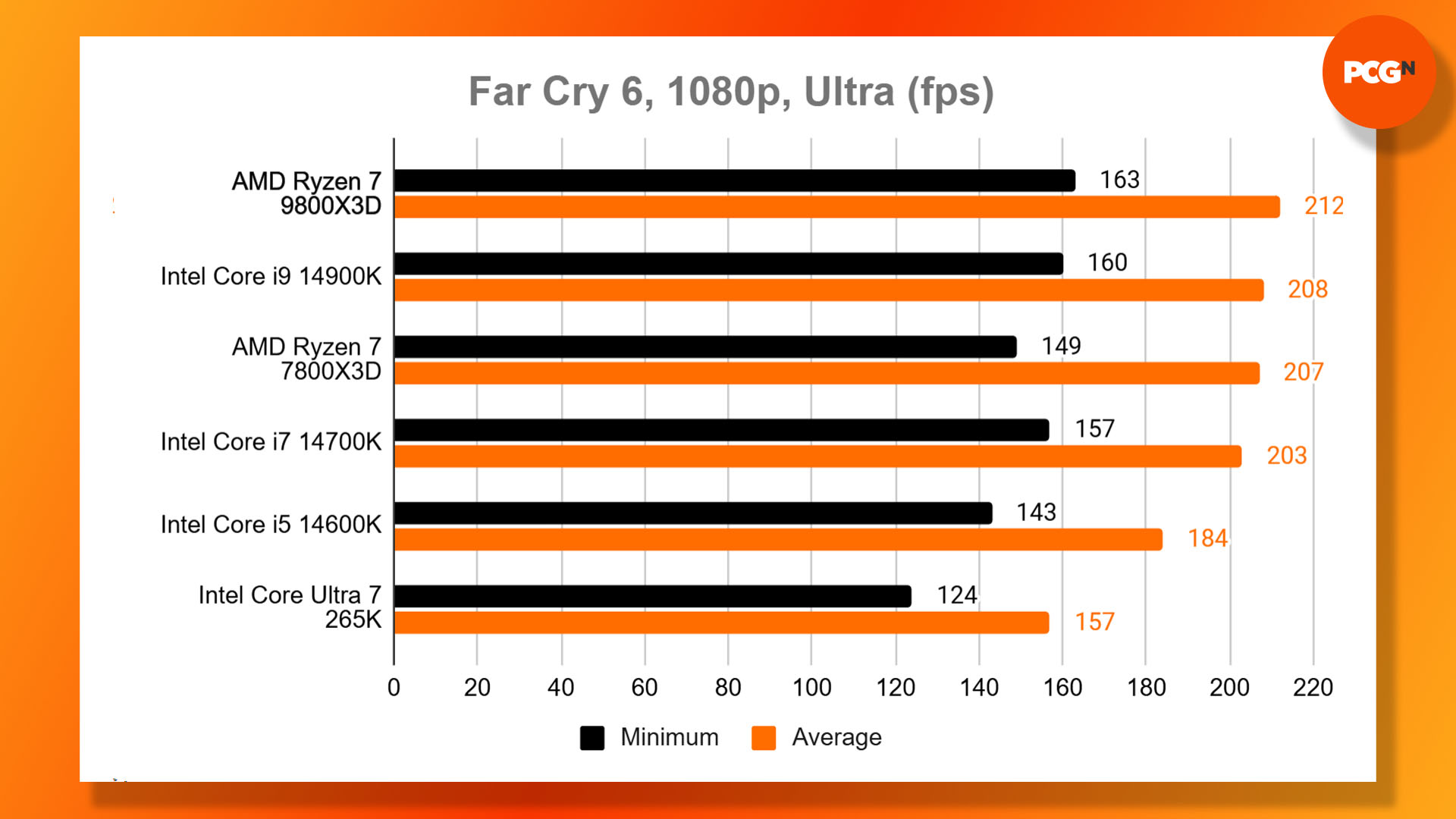
Similarly, in Far Cry 6 the 9800X3D again leads the pack, adding 5fps to the already-high 208fps average from the 7800X3D, and being a massive 35% quicker than the Core Ultra 7 265K. The new AMD chip also overtakes the Intel Core i9 14900K in this test, and is a good 28fps ahead of the Core i5 14600K.
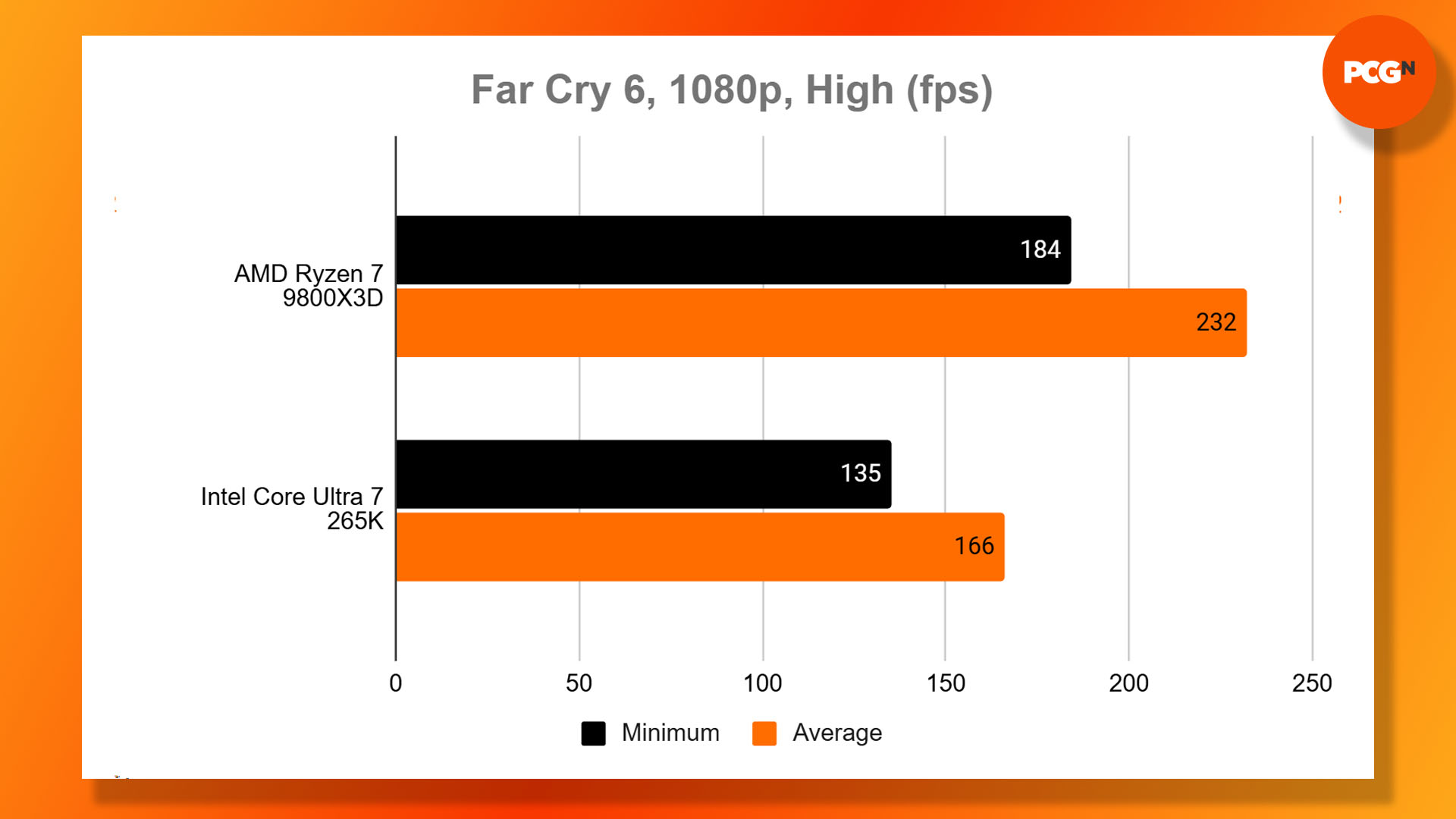
I also ran this game at the High setting on the 265K and 9800X3D, rather than the Ultra setting, to place as much burden on the CPU as possible, and the result is astounding. As you can see in the graph above, the 9800X3D’s average of 232fps is a massive 66fps quicker than the result from the Core Ultra 7 265K, and the minimum is 49fps faster too.
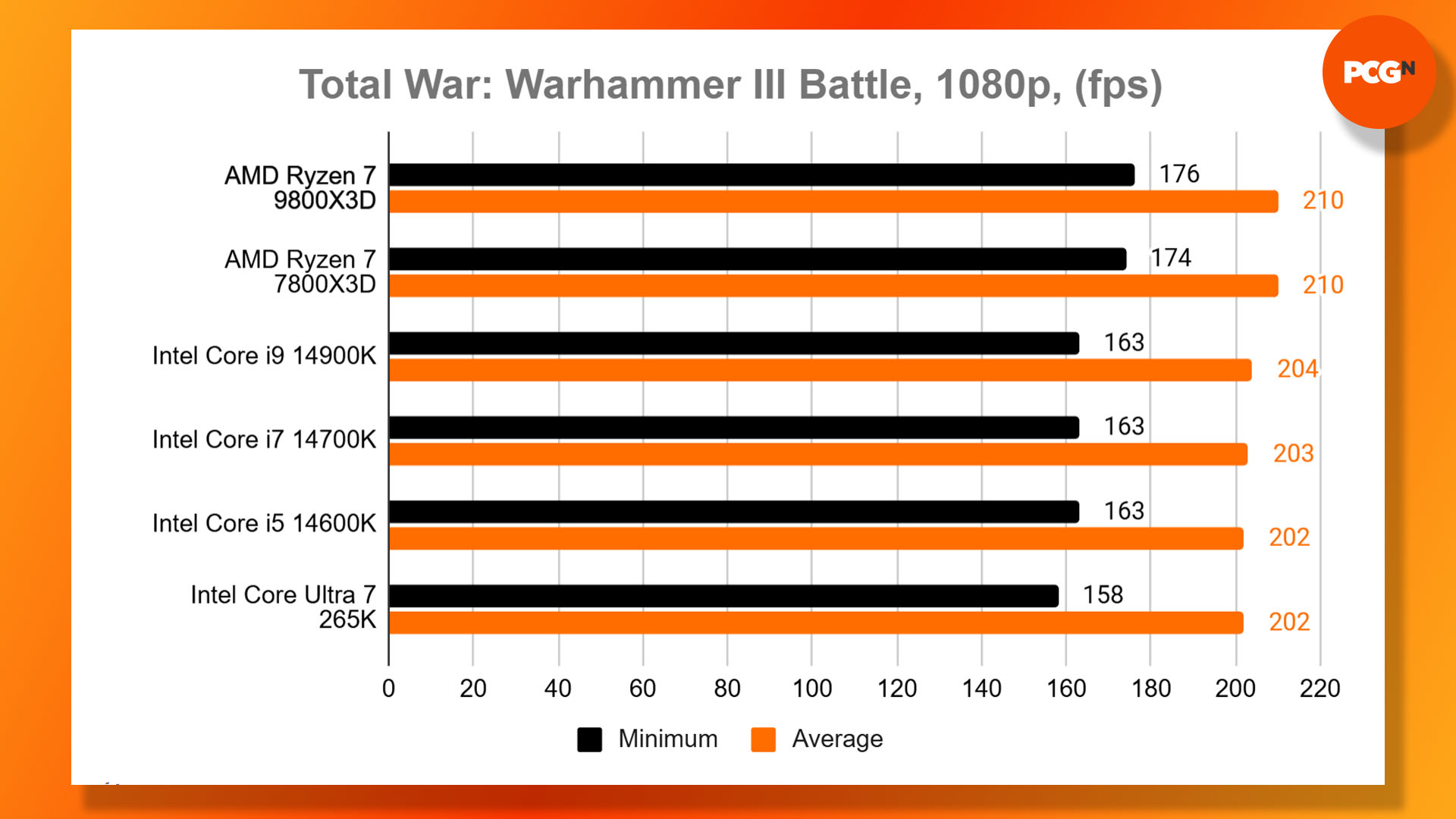
Moving to the Total War: Warhammer 3 Battle test again sees the 9800X3D take the lead, but only by a little compared to the 7800X3D. The minimum is 2fps quicker, but the average is the same. Intel’s CPUs are only a little way behind in this test too, with the minimum frame rate showing where AMD’s X3D chips really help. This is also one test where Intel’s Arrow Lake chips hold up comparably well. The Core Ultra 7 265K is still at the bottom, but not by a huge margin.
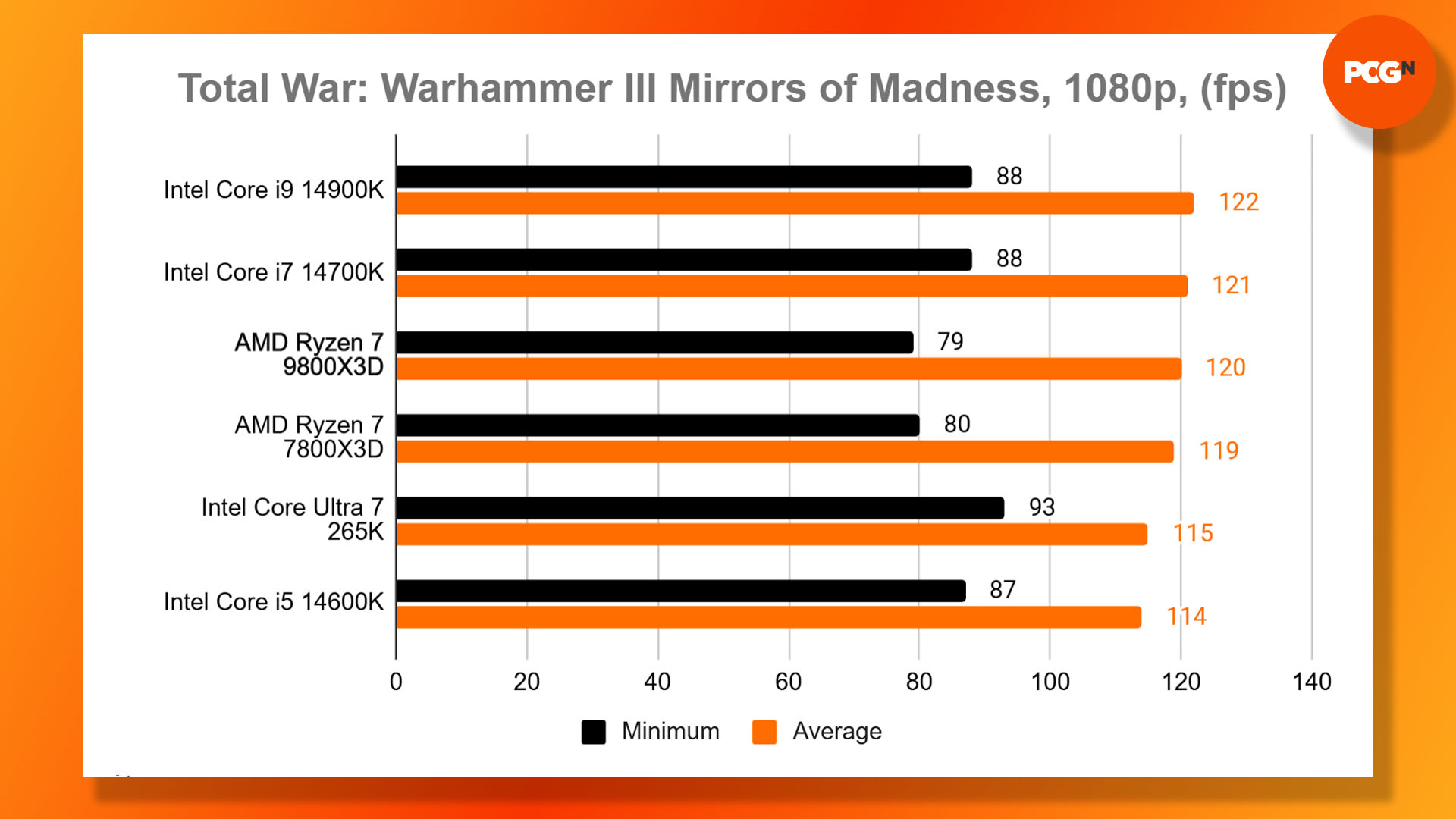
Moving to the Mirrors of Madness benchmark in this same game, and it sees Intel and AMD swap places, though only by a small margin, with the 14900K being 2fps quicker than the 9800X3D. Again, the Core Ultra 7 265K’s average is behind the 9800X3D, though its minimum of 93fps is a rare win for Intel in game benchmarks.
In both the Total War benchmarks, there’s not a lot to separate all these CPUs when it comes down to it. Both the Core i9 14900K and Ryzen 7 9800X3D hold up well, swapping places depending on the type of workload.
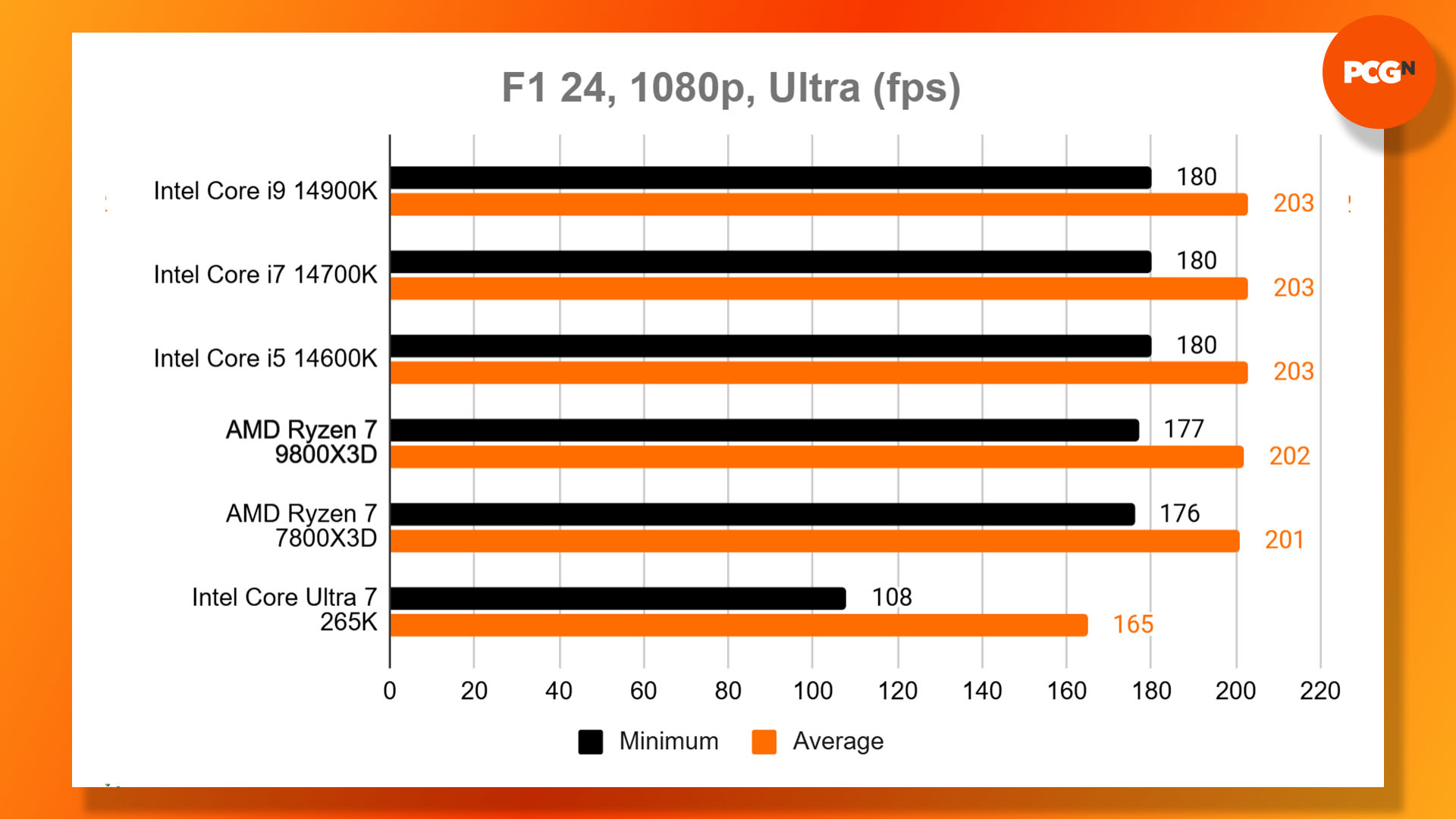
Likewise, our F1 24 benchmark shows there’s not much separating the Intel 14th-gen chips from the 9800X3D, with tiny differences between the chips. The Core Ultra 7 265K really struggles in this test, though, with regular stuttering. This game isn’t a win for the 9800X3D, but it’s right on the heels of the best Intel chips.
With all these tests, however, bear in mind that we’ve deliberately benchmarked this chip at 1,920 x 1,080, as this puts the burden on the CPU rather than the GPU. You’re likely to see diminishing returns from your choice of CPU as you increase the resolution to 2,560 x 1,440 and beyond.
Application benchmarks
Where the 9800X3D really pulls away from the 7800X3D is when it comes to application benchmarks, where its Zen 5 architecture and extra clock speed help bolster its performance. It’s still only an eight-core CPU, so it struggles to compete with chips that have loads of cores, but it’s enormously quicker than the 7800X3D in these tests.
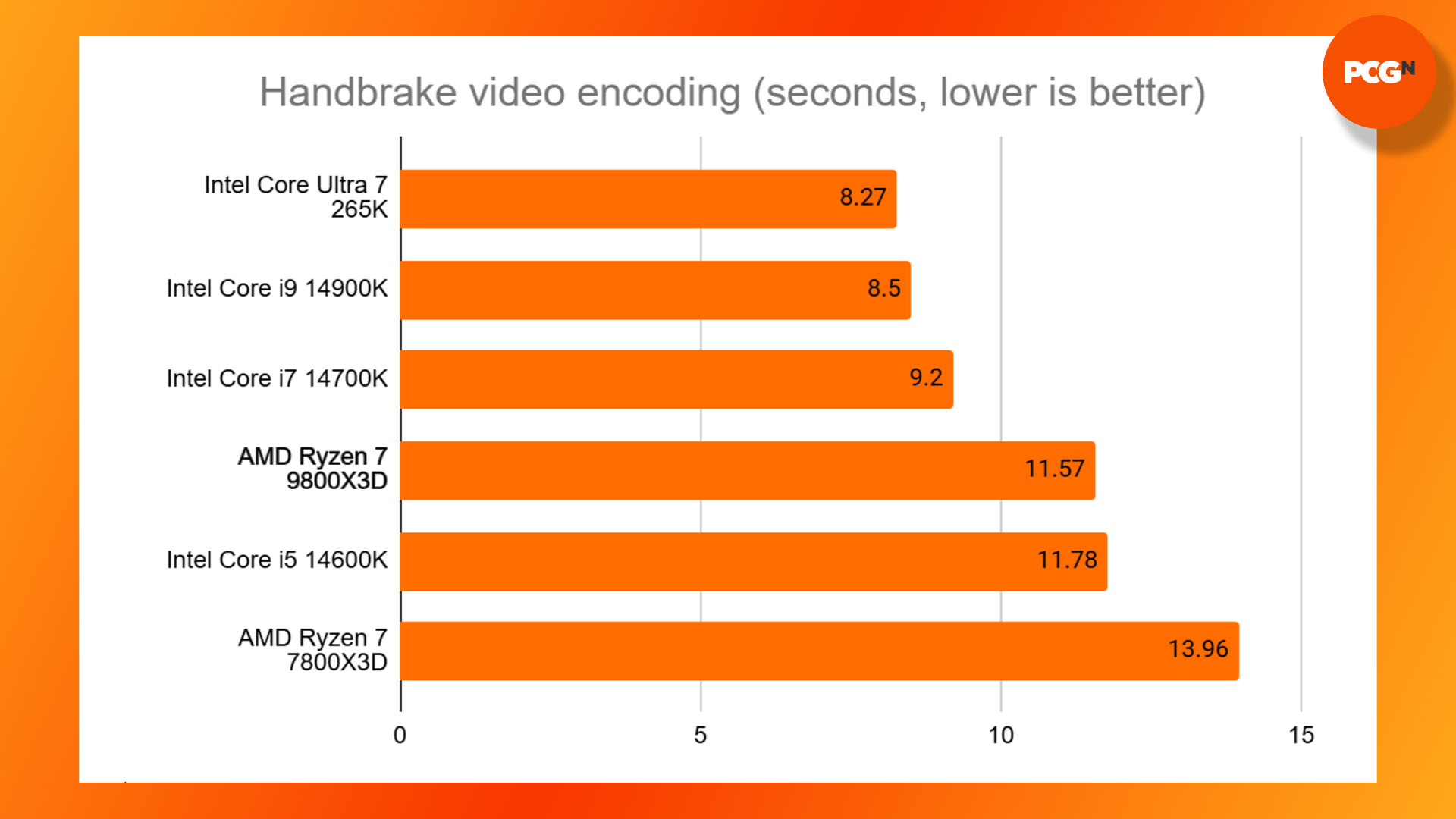
One particularly good result for the new AMD chip was our heavily multi-threaded Handbrake video encoding benchmark, which took 11.57 seconds to complete on the Ryzen 7 9800X3D. That’s over two seconds quicker than the 7800X3D in the same test, and it’s also slightly quicker than the Core i5 14600K, which has six P-Cores and eight E-Cores (a total of 14). That’s a decent result for an eight-core chip.
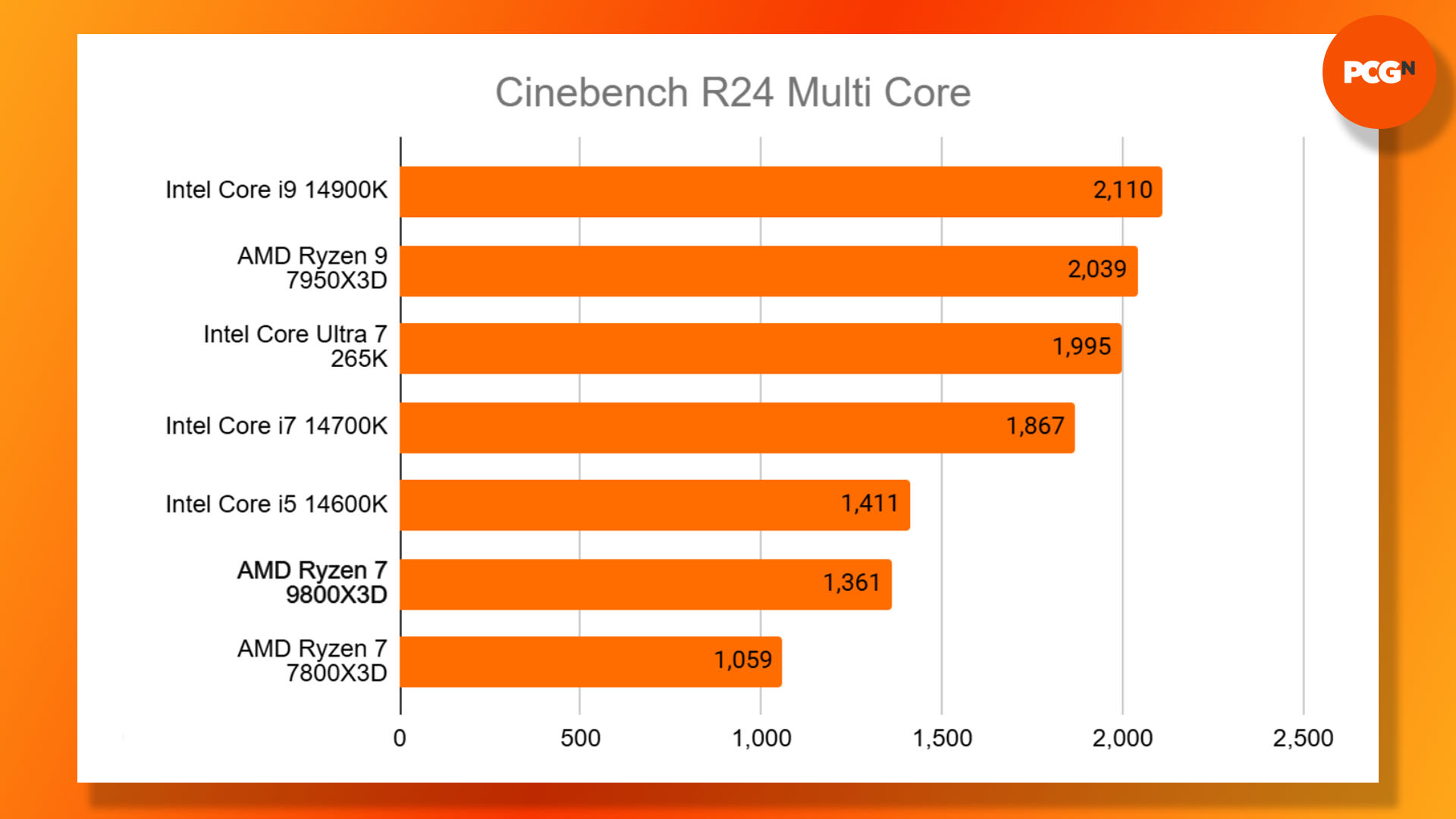
The 14-core Intel CPU still wins out in the Cinebench R24 Multi Core test, but you can see the big jump between the 7800X3D and 9800X3D in the graph above. The 9800X3D scores 1,361, while the lower-clocked 7800X3D only produces a result of 1,059 – you get a 28.5% jump in performance by upgrading to the 9800X3D in this benchmark.
On the other hand, it’s worth noting that the 7800X3D was famously underpowered in this test, and that cheaper chips with more cores are faster. This is where the new Intel Core Ultra 7 265K shines, for example, as does the Core i9 14900K with its 24 Raptor Lake cores. If you really want a CPU that can cope with both gaming and heavily multi-threaded workloads, the Core i9 14900K remains a better option for now.
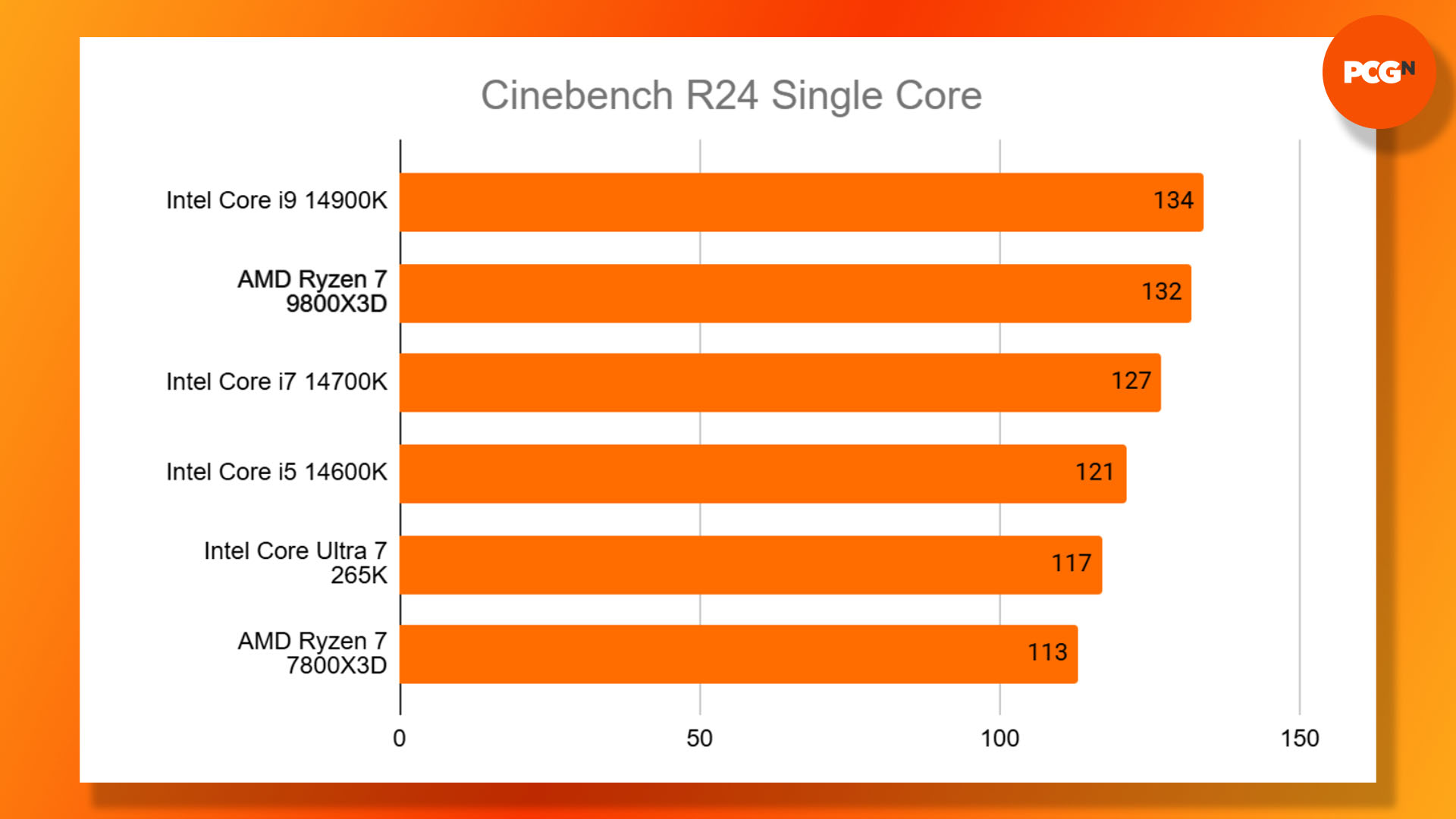
It’s the Cinebench R24 Single Core test that really shows the strength of this new CPU, though. Its extra clock speed and superior architecture not only make it 16.8% quicker than the 7800X3D, but in this test, it even overtakes the 5.6GHz Core 17 14700K. It can’t quite catch the 6GHz Core i9 14900K, but it’s really not far off the pace.
Power draw
One area that Intel has nailed lately is power draw and heat output, and while the 9800X3D is still a power-frugal chip compared to the 14900K, its extra clock speed sees it drawing more from the mains than the 7800X3D, and significantly more than the Core Ultra 7 265K.
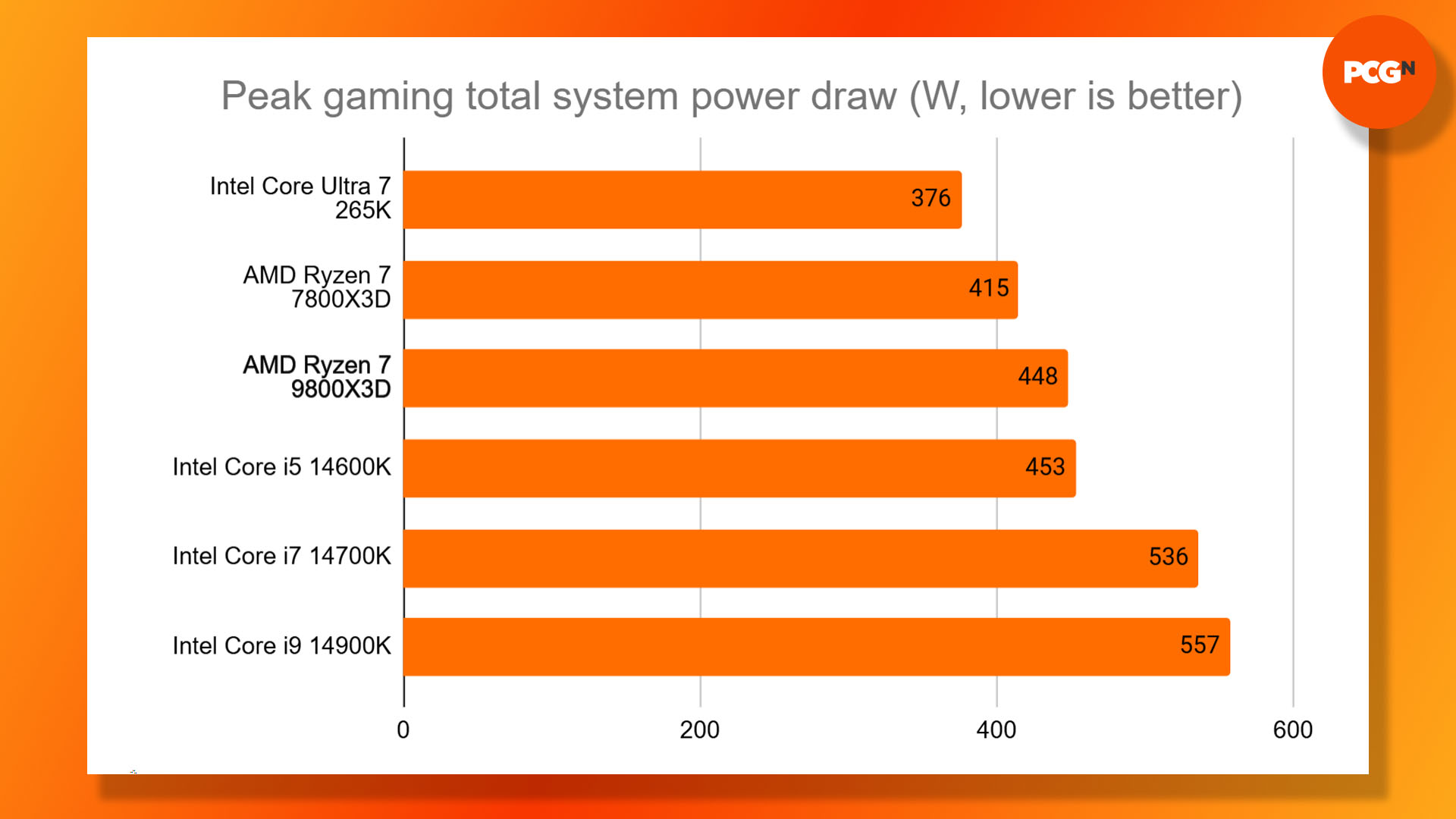
When it comes to gaming, the poor frame rates of the Core Ultra 7 265K largely make this point moot in terms of efficiency, and while the 9800X3D does draw 33W more power than the 7800X3D in our test rig during games, it’s still massively more efficient than the Core i7 14700K and 14900K.
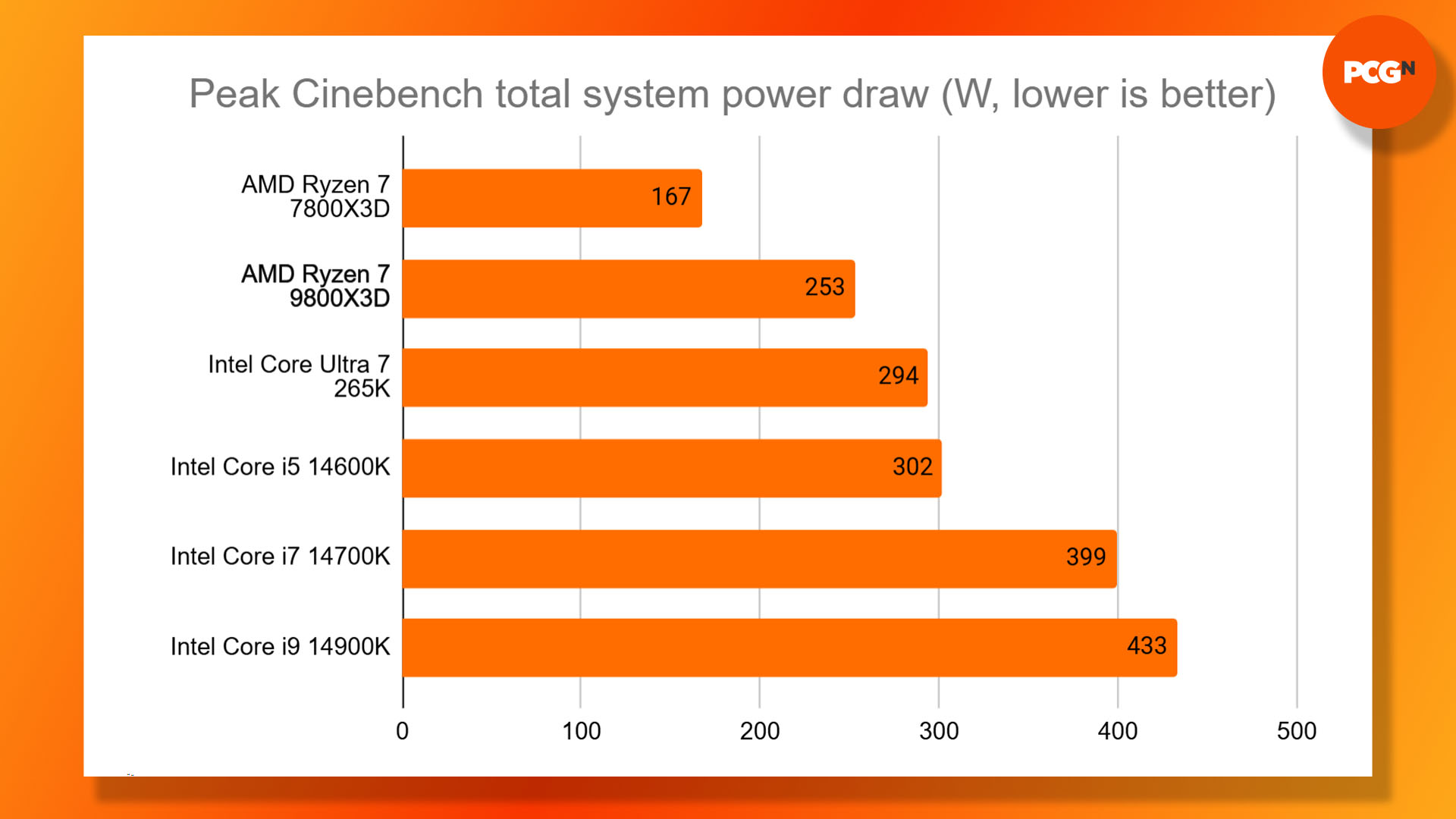
However, you really see an increase in power draw when you stress all the 9800X3D’s cores at once, with the total system power consumption jumping from 167W with the 7800X3D installed to 253W with the 9800X3D. This is undoubtedly an area where Intel Arrow Lake has the upper hand, with the Core Ultra 7 265K system only drawing an extra 41W from the mains, while also increasing performance by a massive 46.58%.
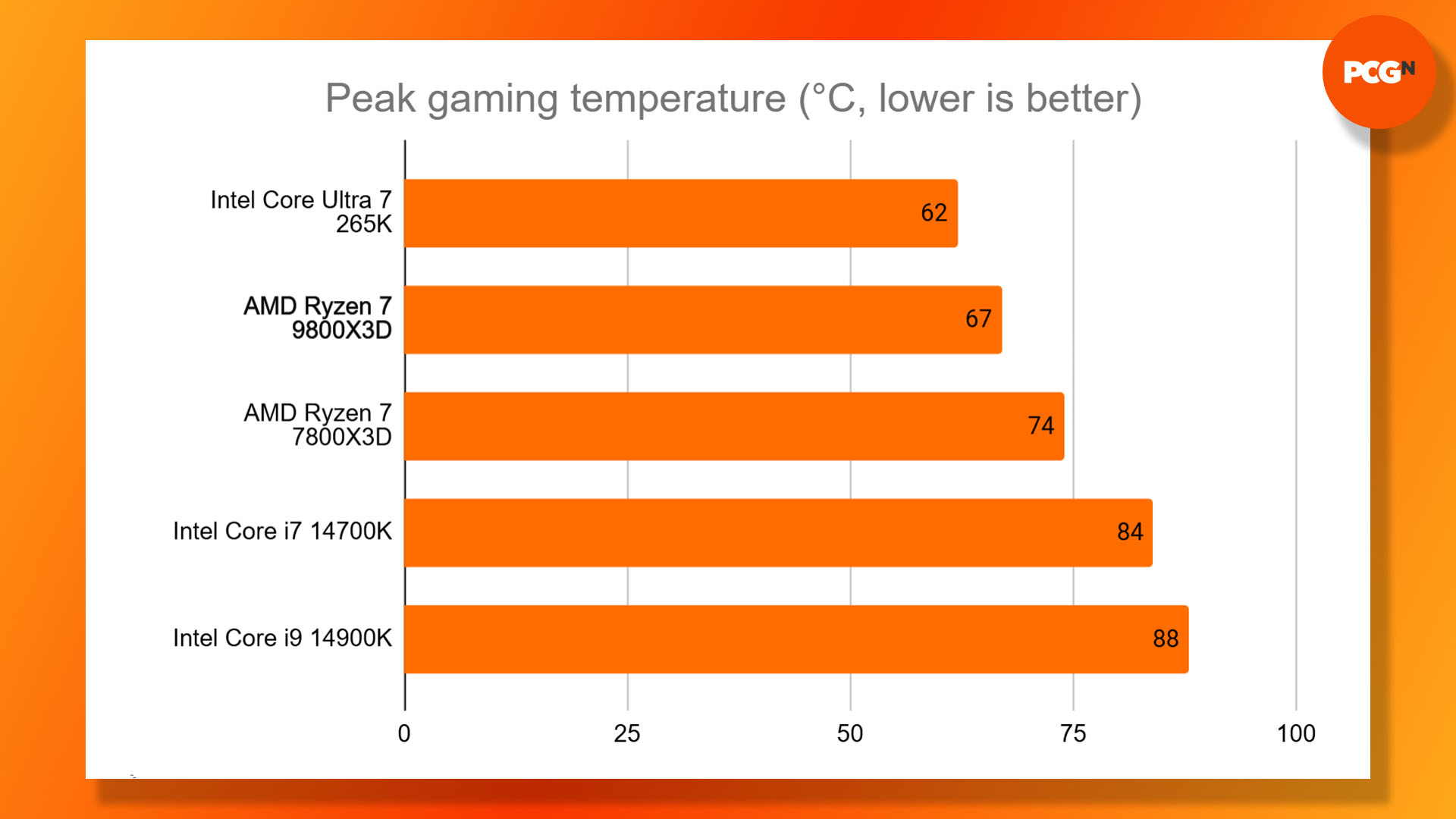
The same also goes for operating temperature, where the Core Ultra 7 265K is cooler at peak load in gaming than the 9800X3D. However, we were pleasantly surprised to see that the 9800X3D ran a good 7°C cooler than the 7800X3D in this test, under the same conditions with the same CPU cooler.
Putting the cache underneath the CCD, so the CPU cores get direct access to the heatspreader and CPU cooler contact plate, clearly works well for thermals for gaming. However, the extra clock speed equally results in a hotter-running CPU when all the cores are engaged, as the 9800X3D hit 84°C in our Cinebench Multi Core test.
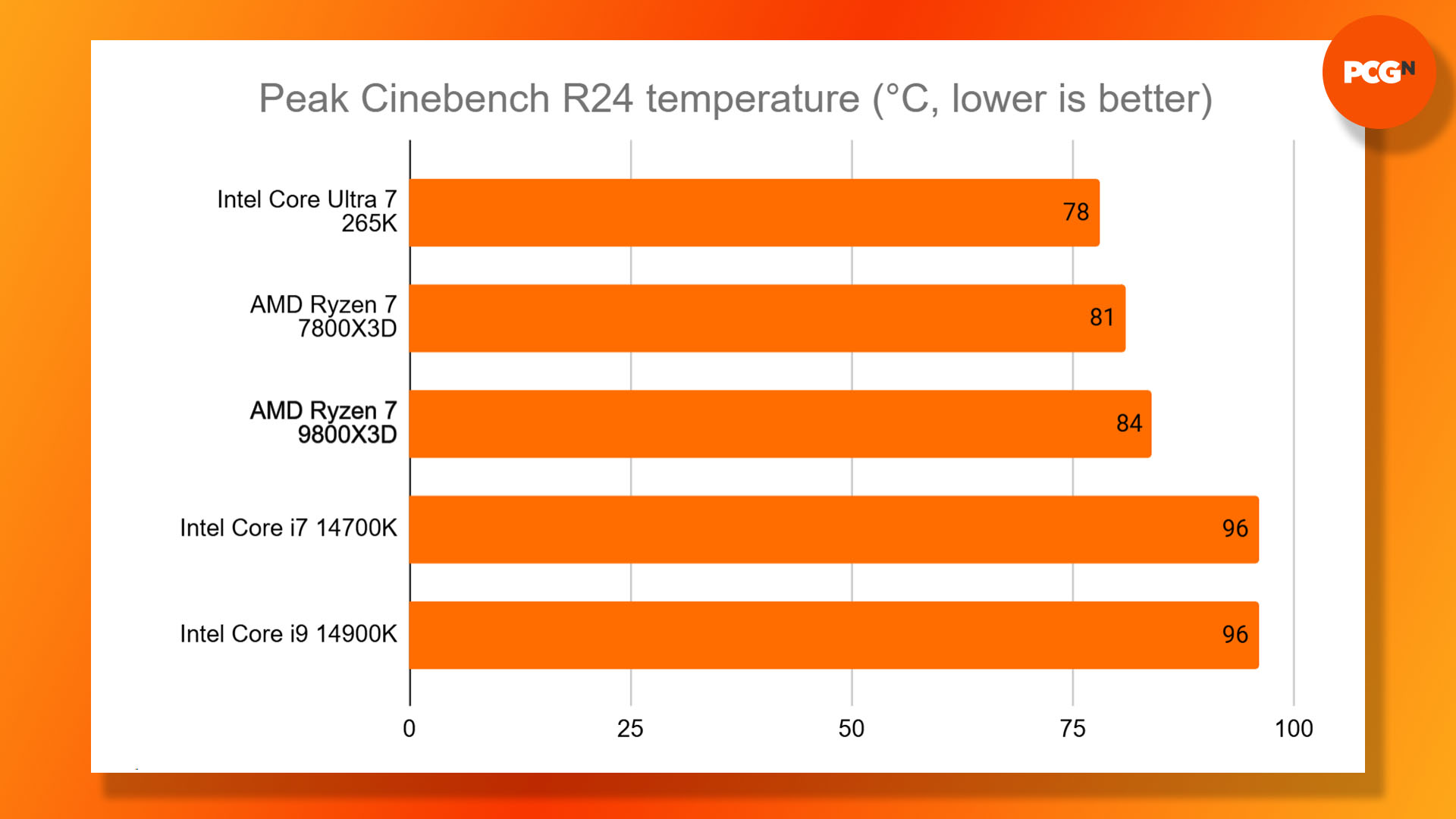
That’s 3°C warmer than the 7800X3D, and 6°C hotter than the Core Ultra 7 265K, but it’s still a long way from the sky-high temperatures of Intel’s 14th-gen chips when all their cores are running at full load. A 240mm AIO cooler or premium air cooler will be fine for the Ryzen 7 9800X3D.
Price
The AMD Ryzen 7 9800X3D price is $479, which is a lot to ask for an eight-core CPU, and a good $30 more than the 7800X3D launch price. That might look like a bad deal when you can get the 24-core Intel Core i9 14900K for $439, but the 9800X3D’s superior gaming performance justifies the extra cost, as does its superior power efficiency and cooler operating temperature.
AMD knows the value of this CPU, and has priced it as high as it can go without looking ridiculous. As an all-rounder, the 9800X3D price isn’t cheap, even with the improved multi-threading performance over the 7800X3D, but at least it comes in under $500.
Alternatives
AMD Ryzen 7 7800X3D
Despite limited stock right now, AMD tells us that it currently has no plans to remove the 7800X3D from its roster, and we’re hoping that the introduction of the 9800X3D means the price of the 7800X3D will come down in the near future.
Assuming that happens, the 7800X3D is still a formidable gaming chip if you can find it for under $400. Its gaming performance isn’t far off the 9800X3D’s pace, and it doesn’t need loads of cooling power either. The only downer is the lack of clock speed and multi-threaded speed, but otherwise, the 7800X3D remains a great buy if you can find it at the right price.
Intel Core i9 14900K
Intel’s former flagship hasn’t had an easy ride, but it’s still a great all-rounder if you want a CPU that can handle both gaming and serious multi-threaded work. There are some caveats, though. Firstly, you’ll need to flash the BIOS on your motherboard to make sure it has the microcode for the latest Intel CPU fix, or you risk game crashes and even damaging your CPU.
You’ll also need the best power supply you can afford, as well as the best AIO cooler in reach of your budget, as this is a hot-running and power-hungry customer. If you can sort all the above, though, the 14900K is a decent CPU that can turn its hand at anything.
Verdict
Well done AMD, you’ve produced the gaming CPU we wanted, giving us eight cached-up cores with a decent clock speed, and the results are great. If you want the best gaming CPU that money can buy, then this is it right now, and while it’s not cheap, at least the price is still under $500.
The gaming performance is superb, with the 9800X3D outpacing the previous king, the 7800X3D, and absolutely obliterating Intel’s new Arrow Lake CPUs. Meanwhile, the new chip architecture and extra clock speed make the 9800X3D a much better all-rounder than its predecessor.
It still only has eight cores, of course, but that’s plenty for gaming and most people’s multi-threading needs. You’ll only need more if you’re regularly giving your PC large parallel workloads, such as high-resolution video encoding and 3D rendering. For most people’s needs, especially gamers, this chip does it all.
My only main misgivings are the high price for an eight-core chip, and the fact that the low thermals mean AMD could have squeezed a higher boost clock out of it, making it even faster at its stock boost speed, without requiring overclocking – 5.2GHz is still quite a low top frequency for a chip at this price.
Otherwise, though, the Ryzen 7 9800X3D is a triumph, fixing the main issues with the 7800X3D, while making a new CPU that’s even faster in games. I’m really looking forward to seeing what AMD can do with the rest of the X3D lineup, particularly if it can solve the cache latency issues with the 12-core and 16-core chips.
If you’re thinking about assembling a new 9800X3D rig, check out our full guide on how to build a gaming PC, as well as our guide on the best gaming RAM to install in your new system.
